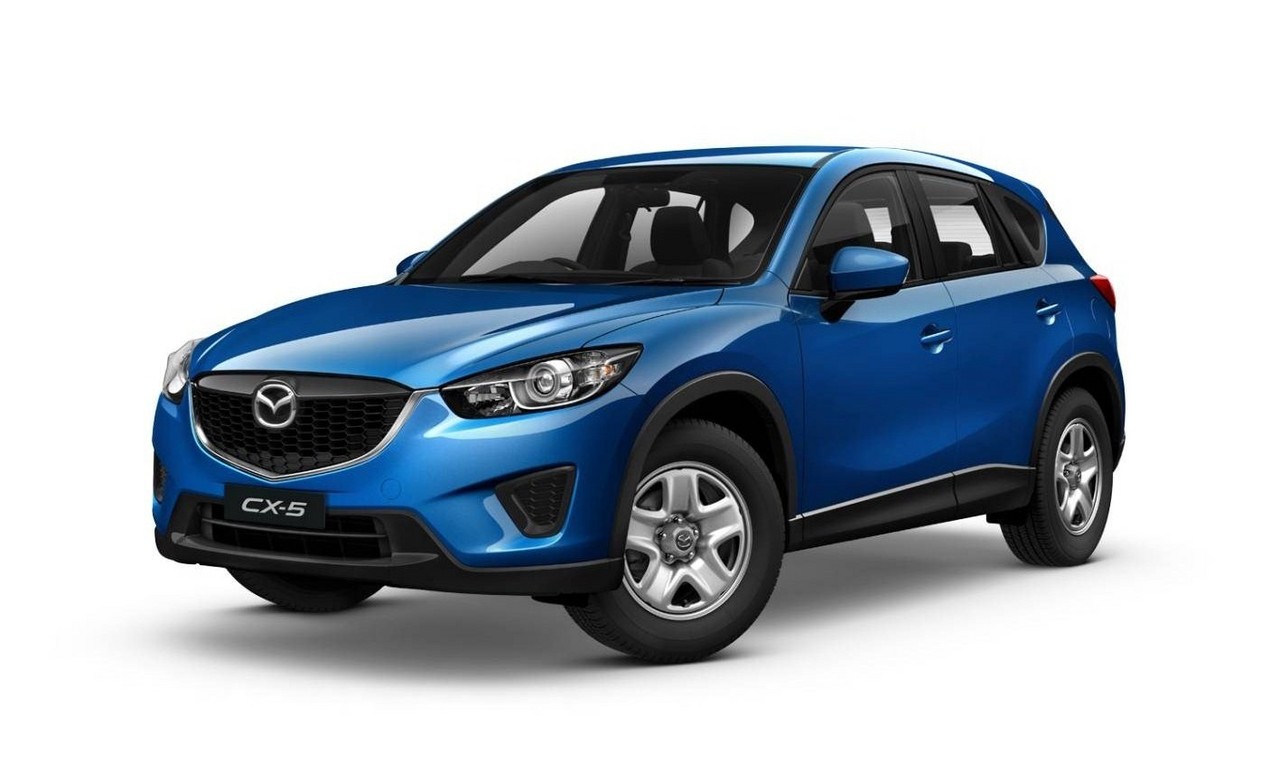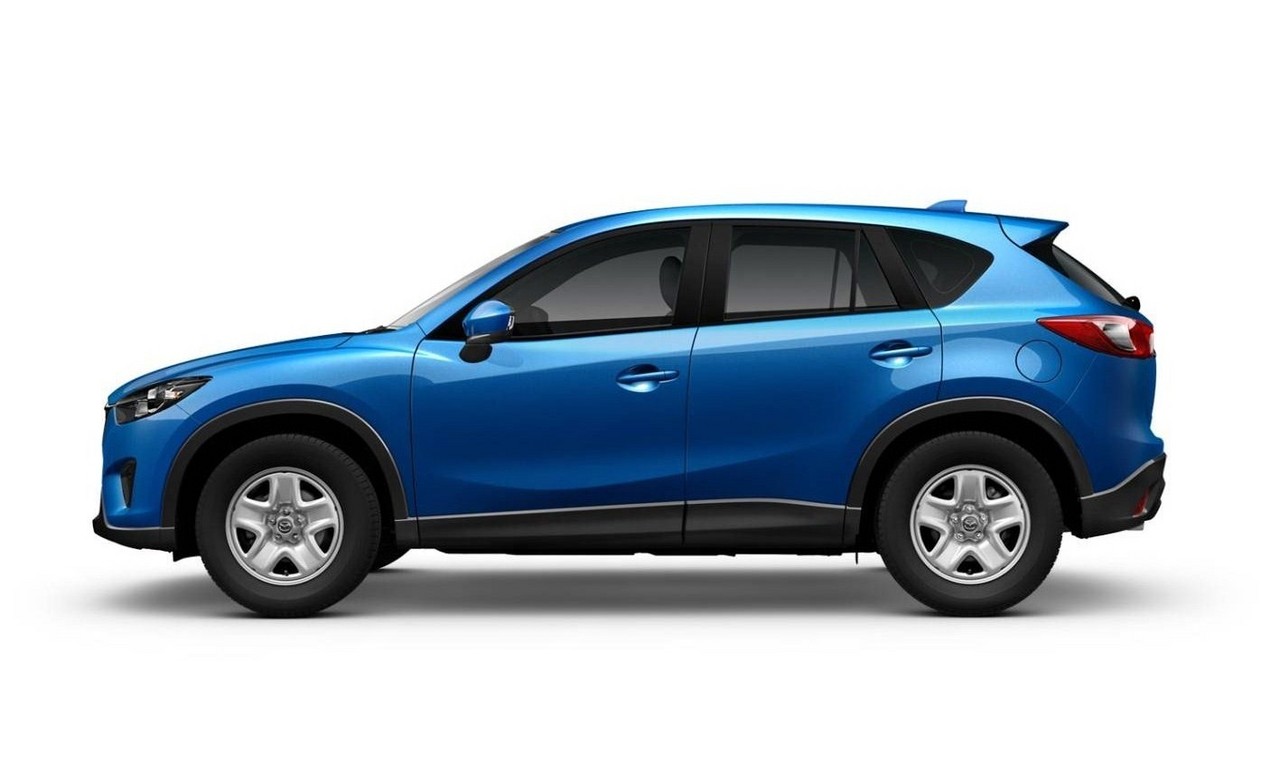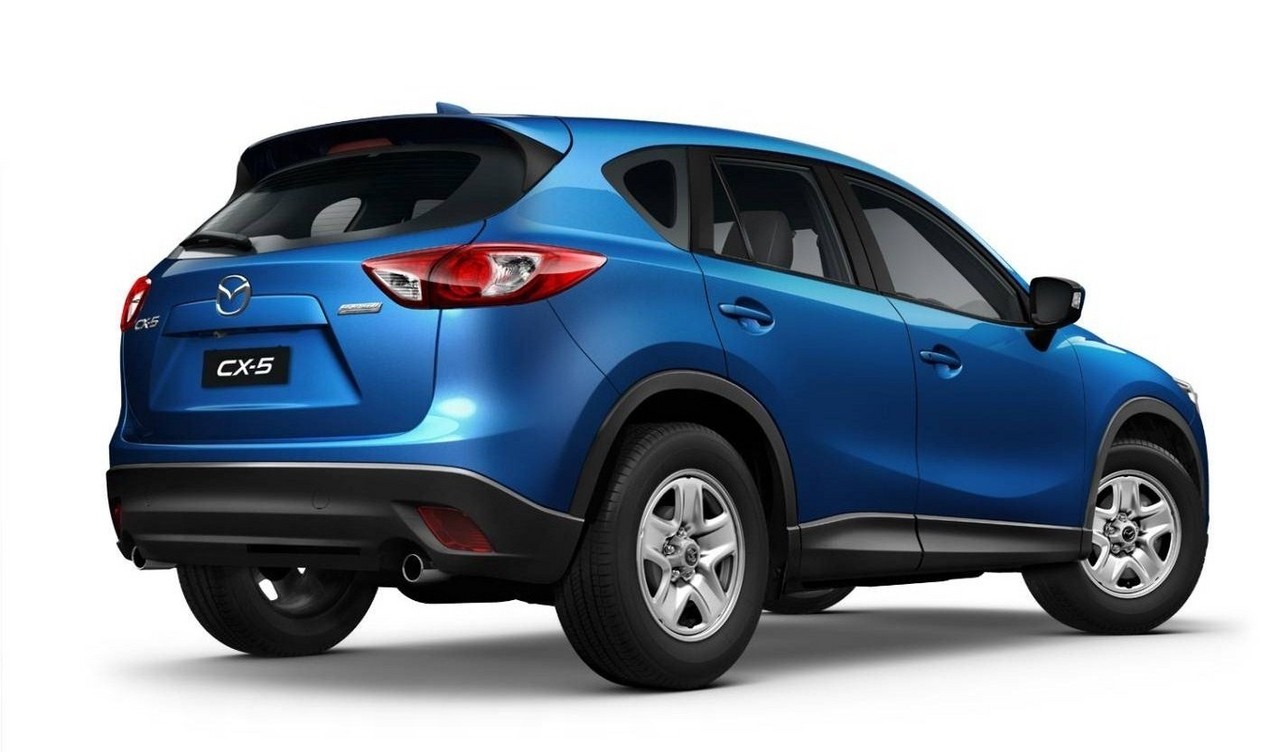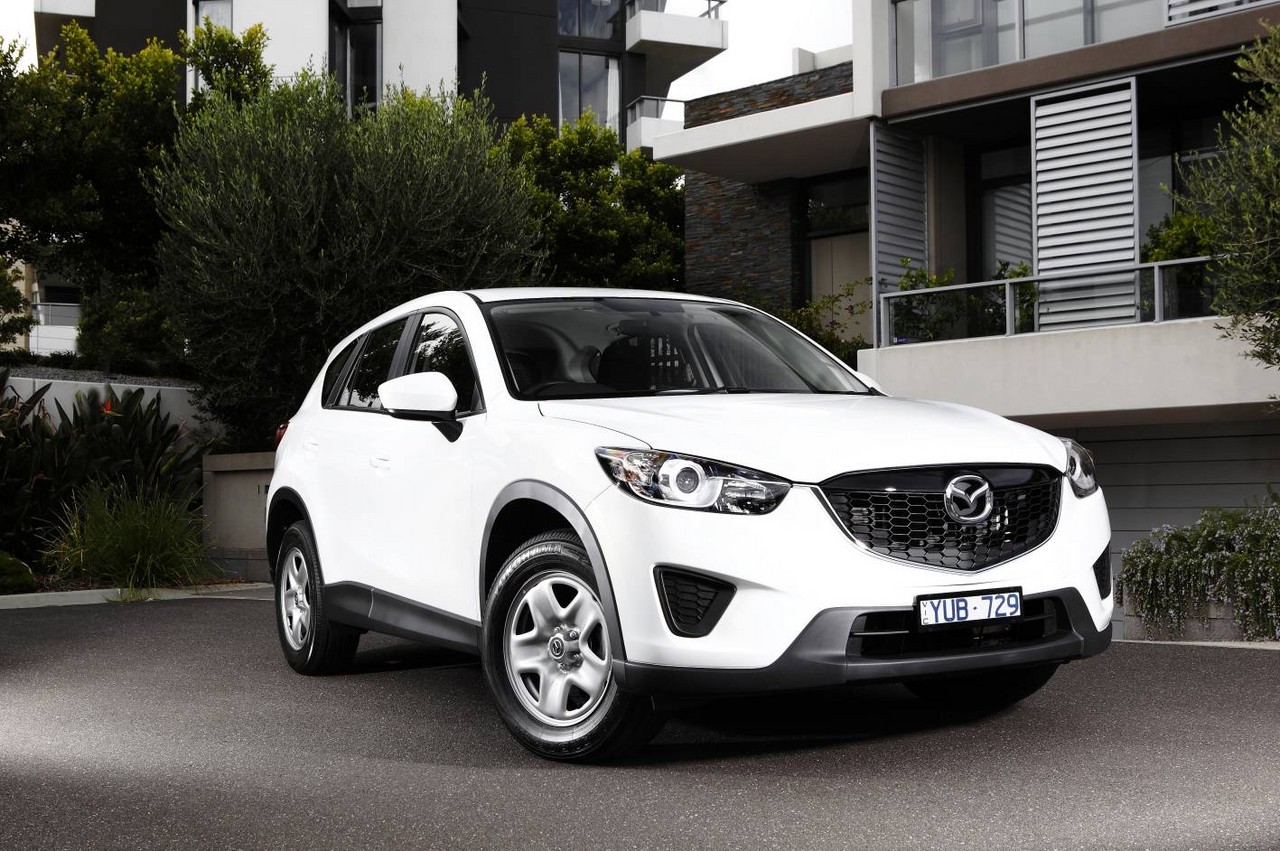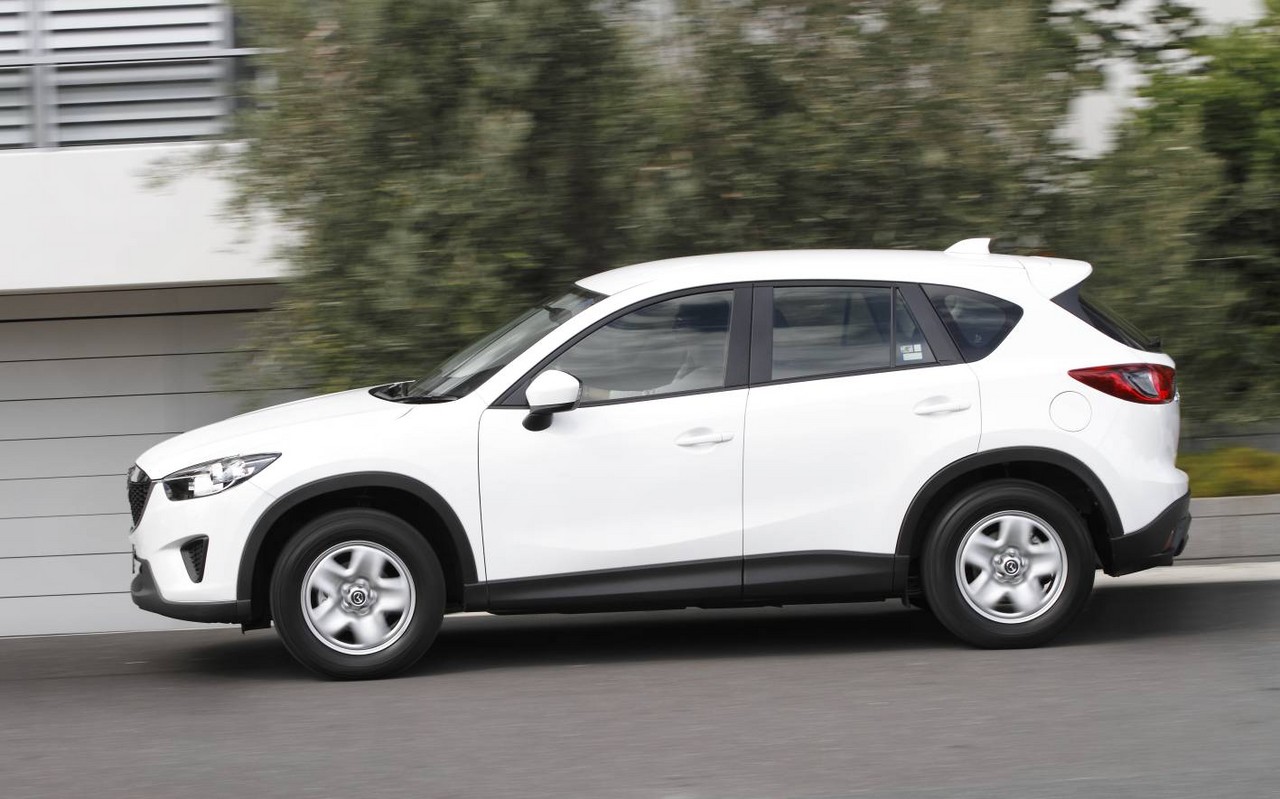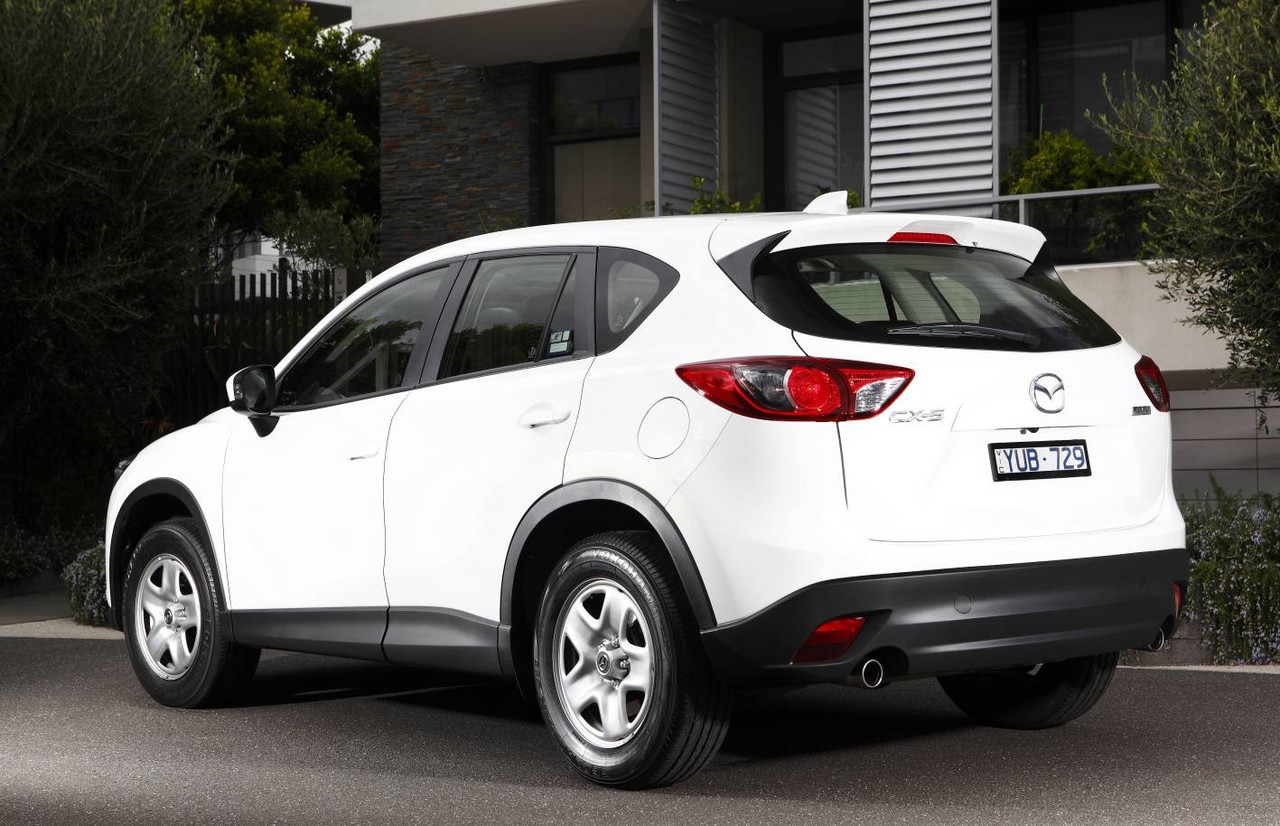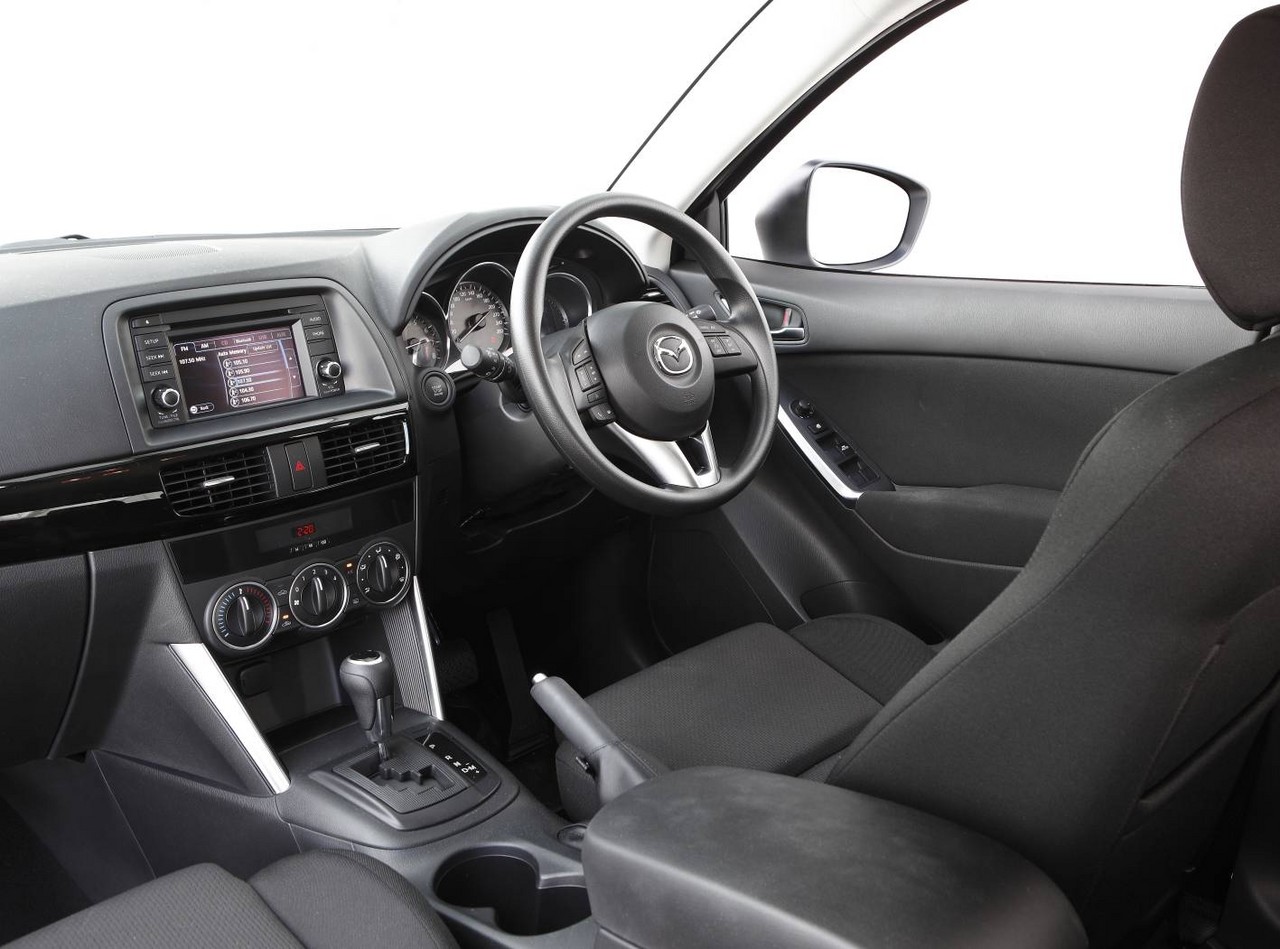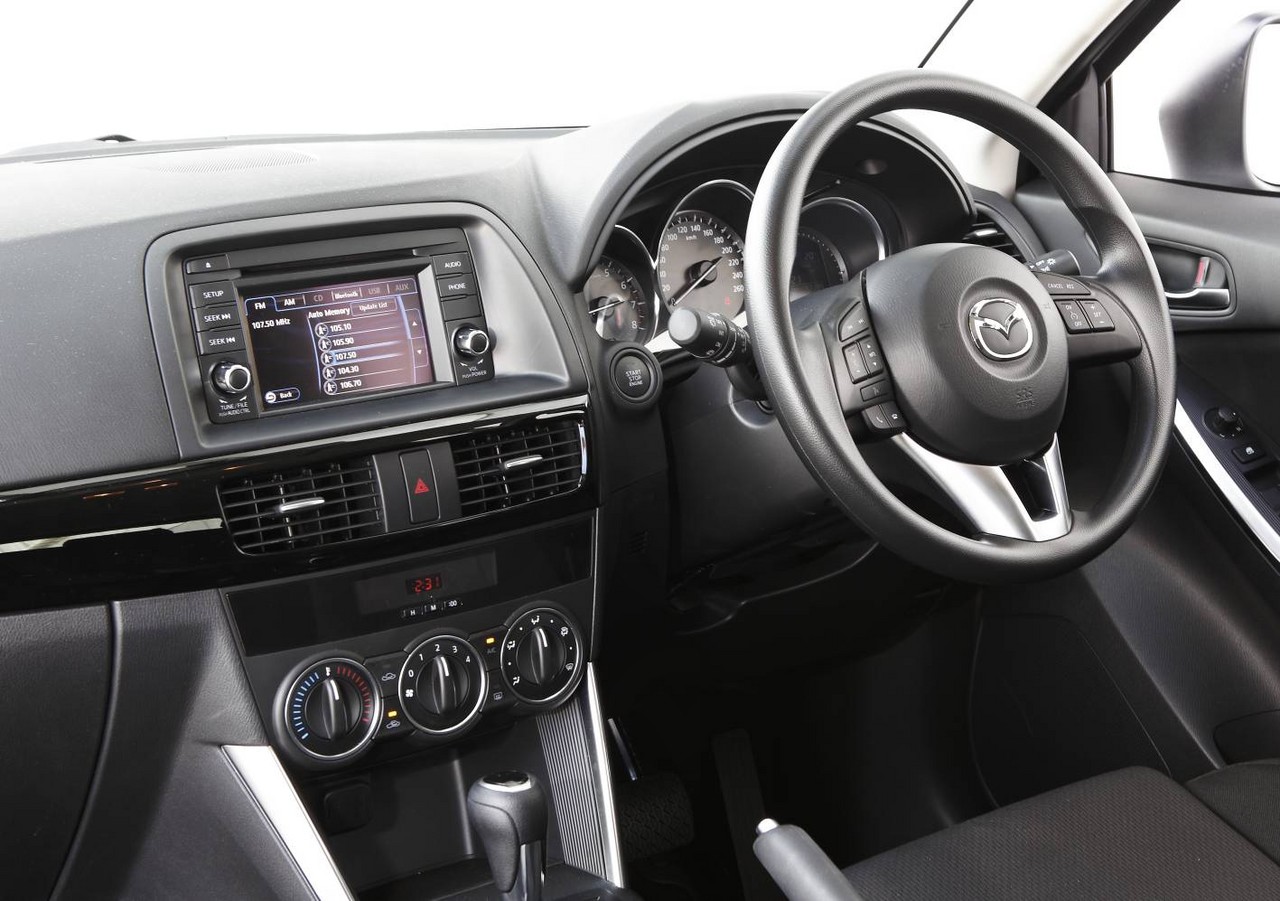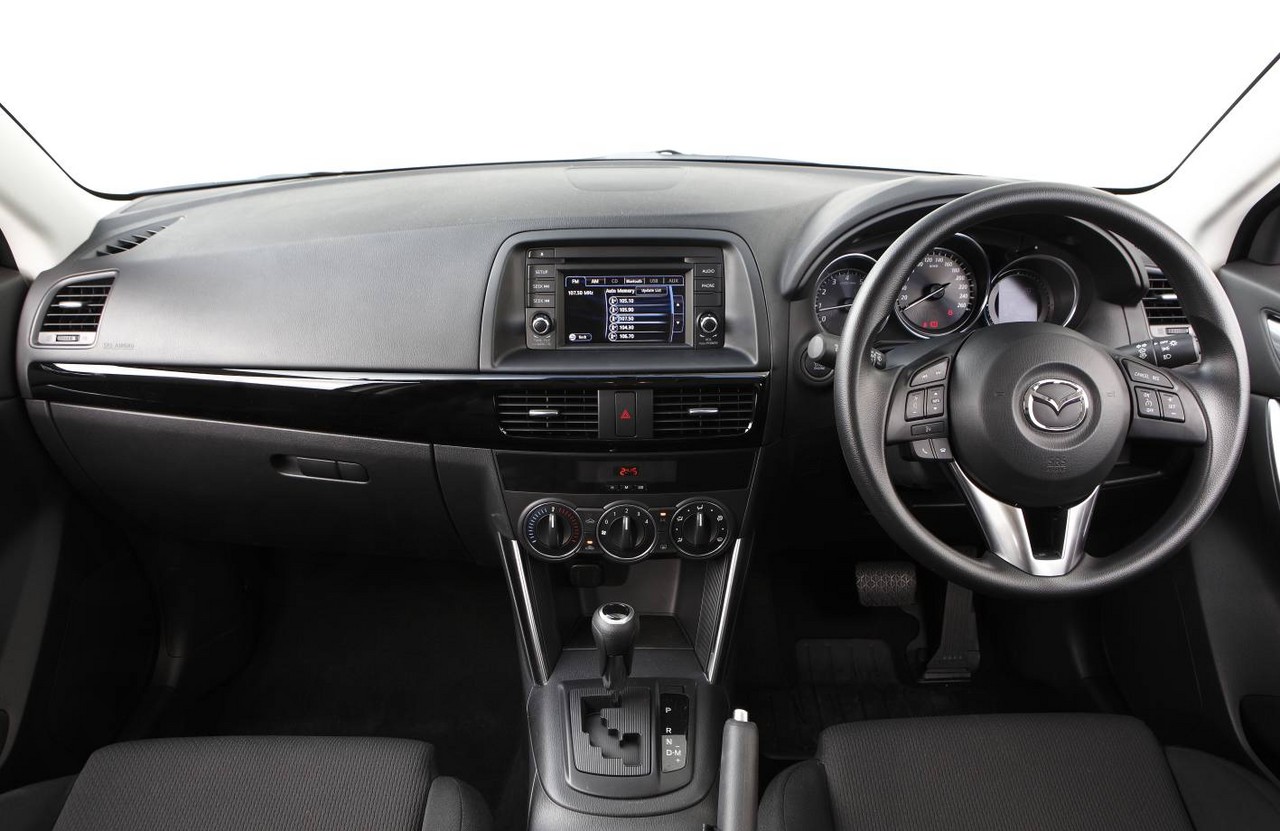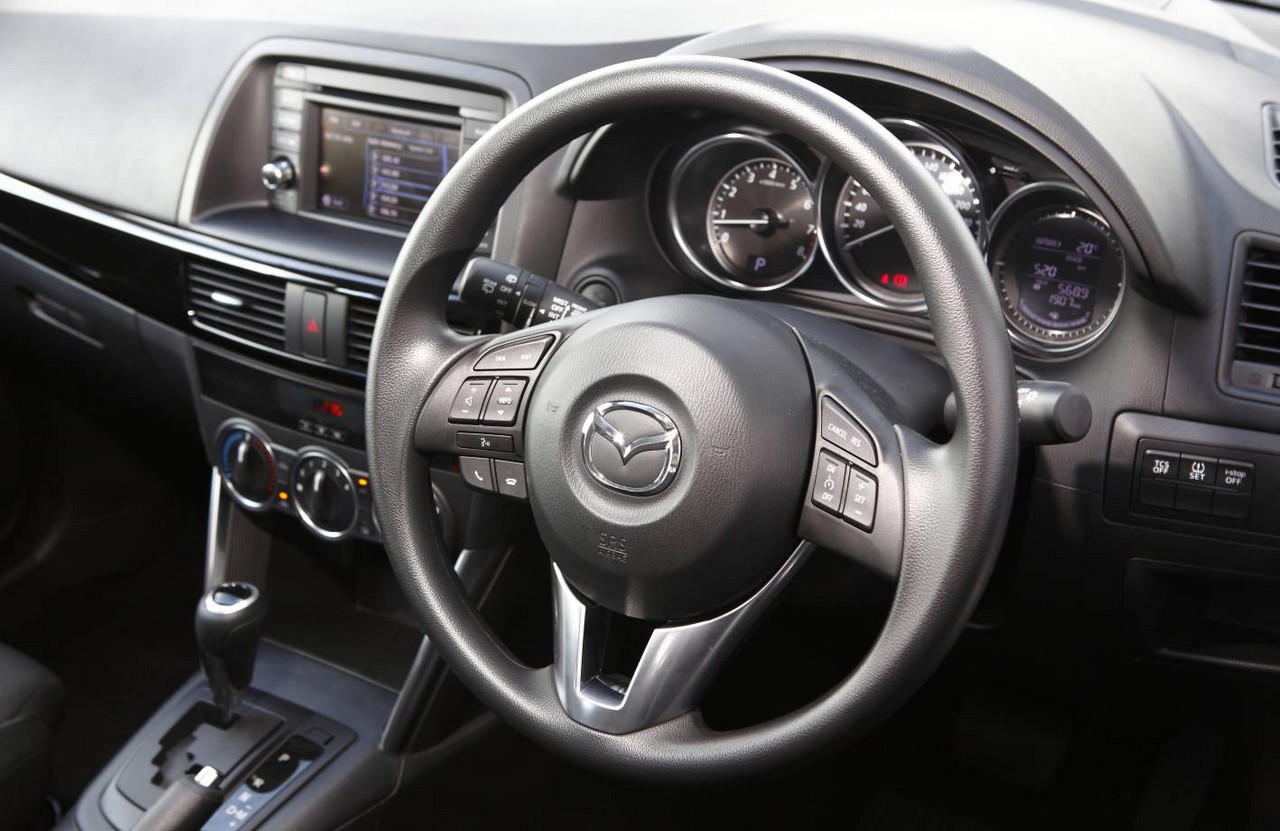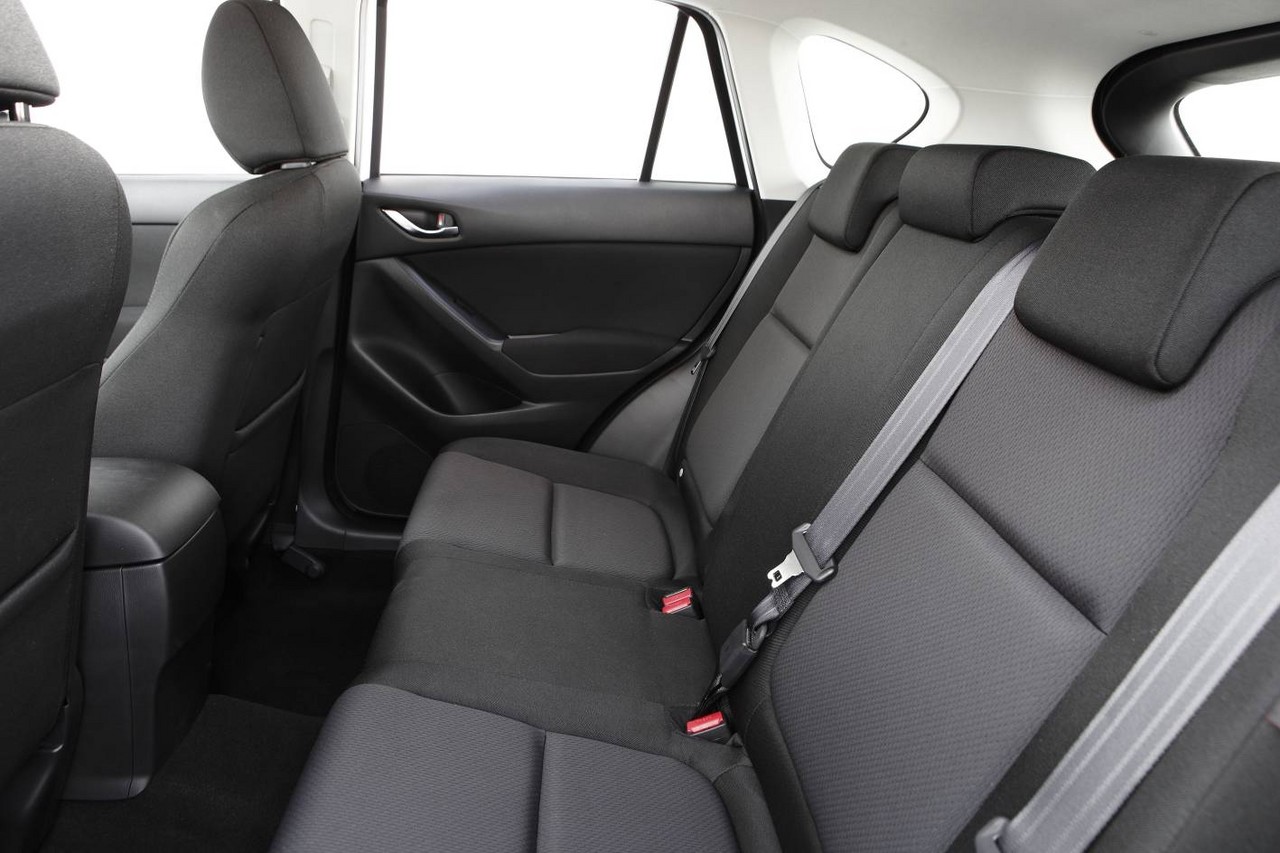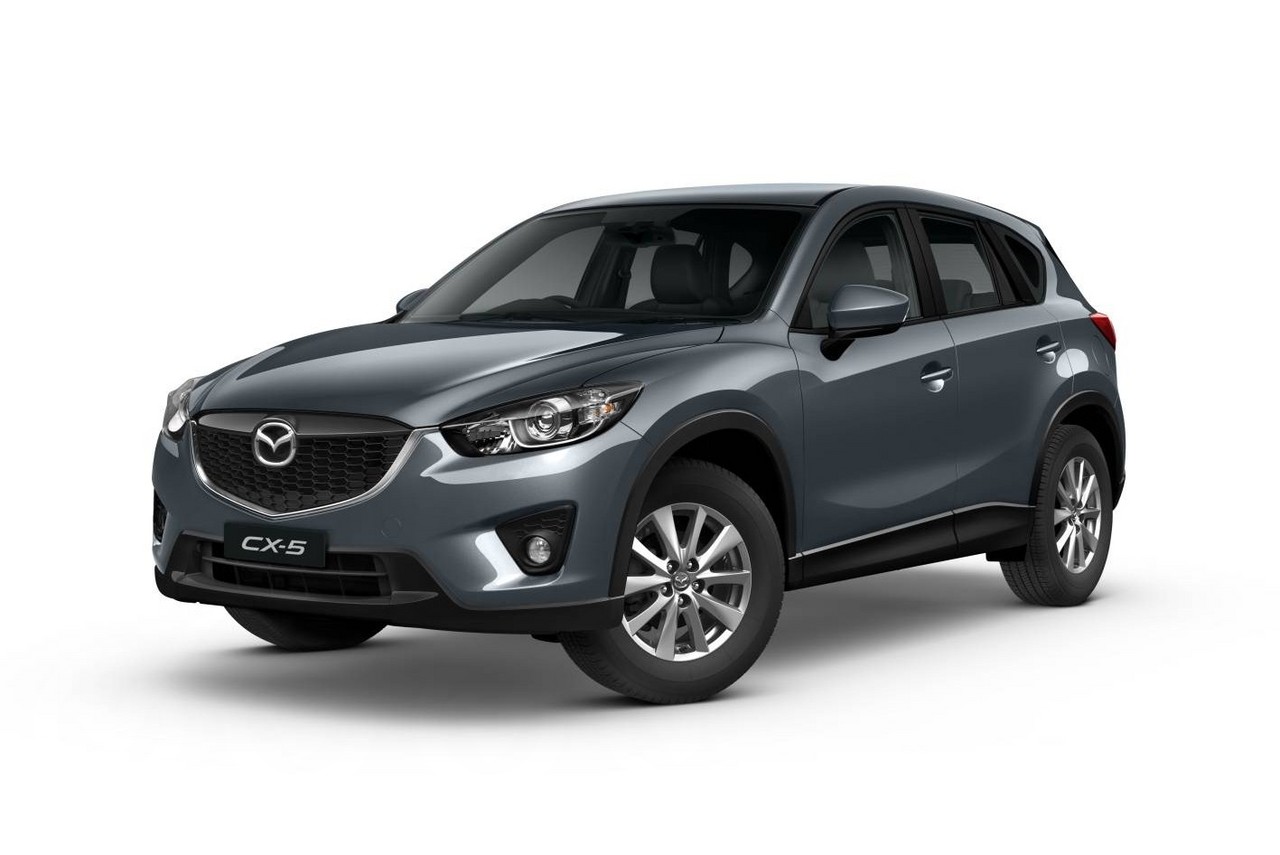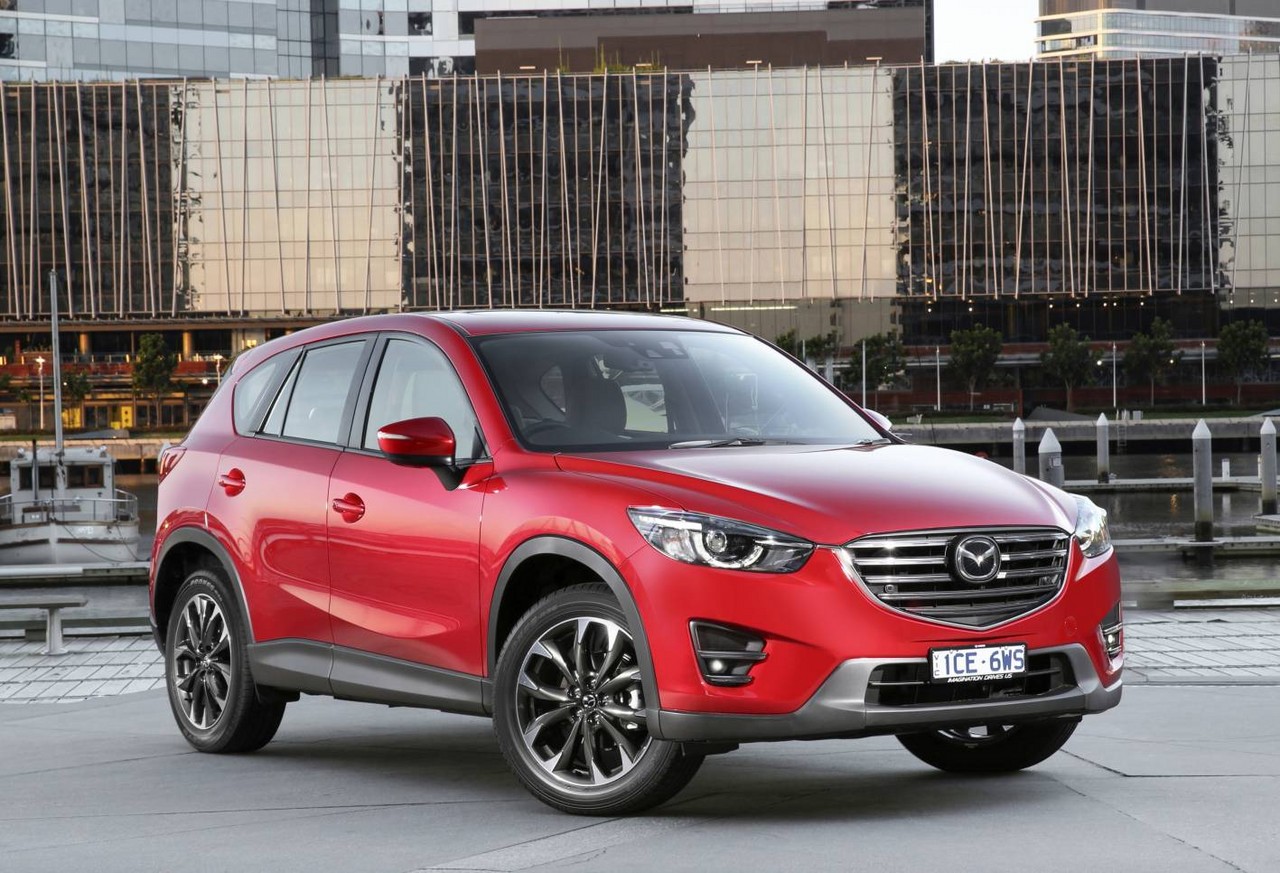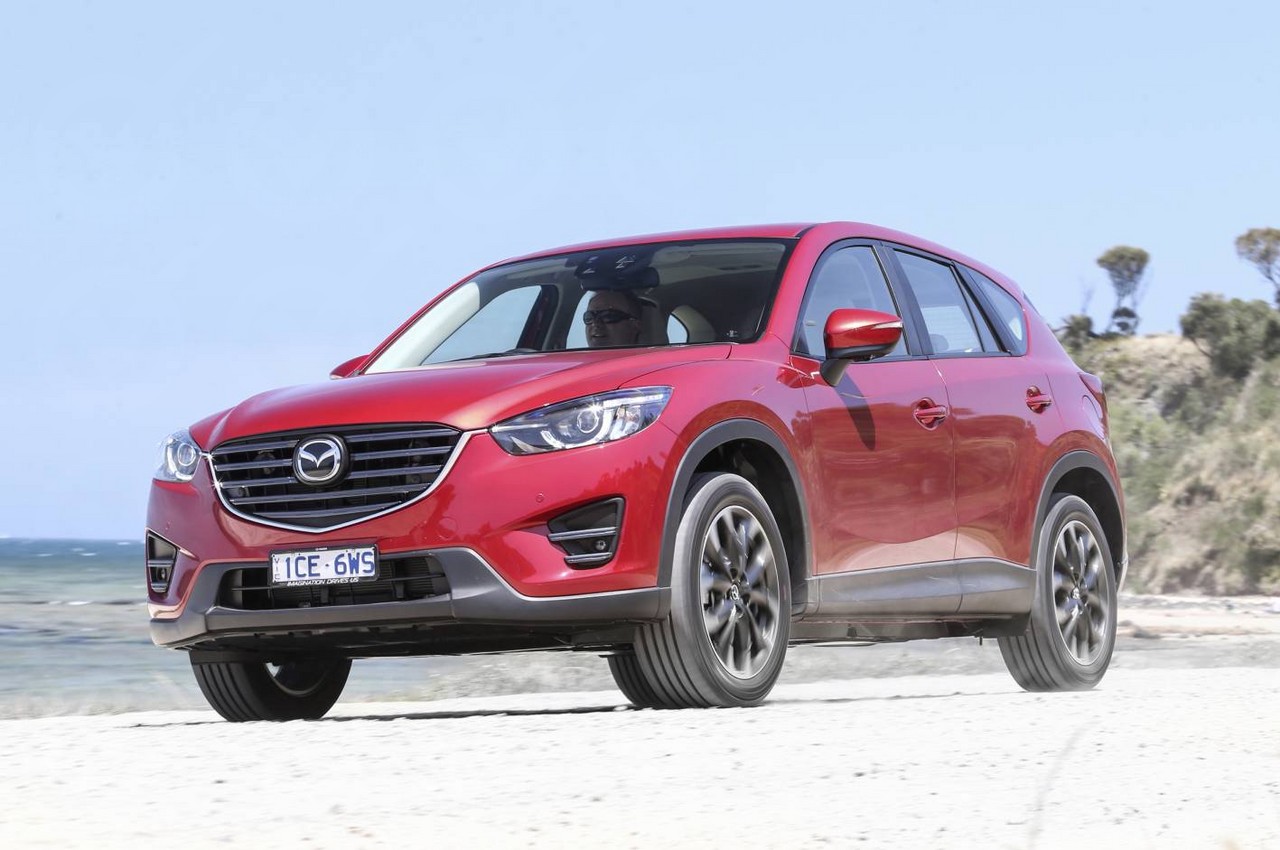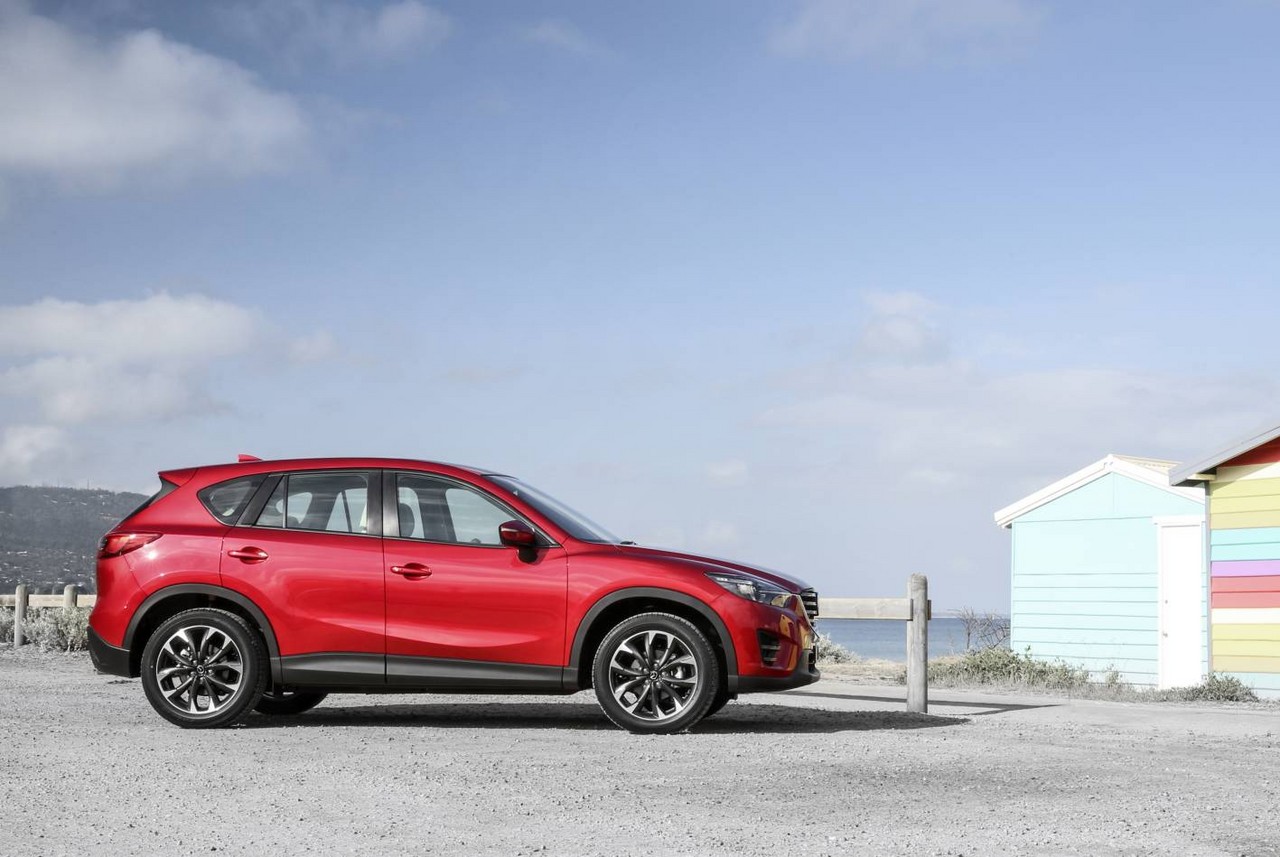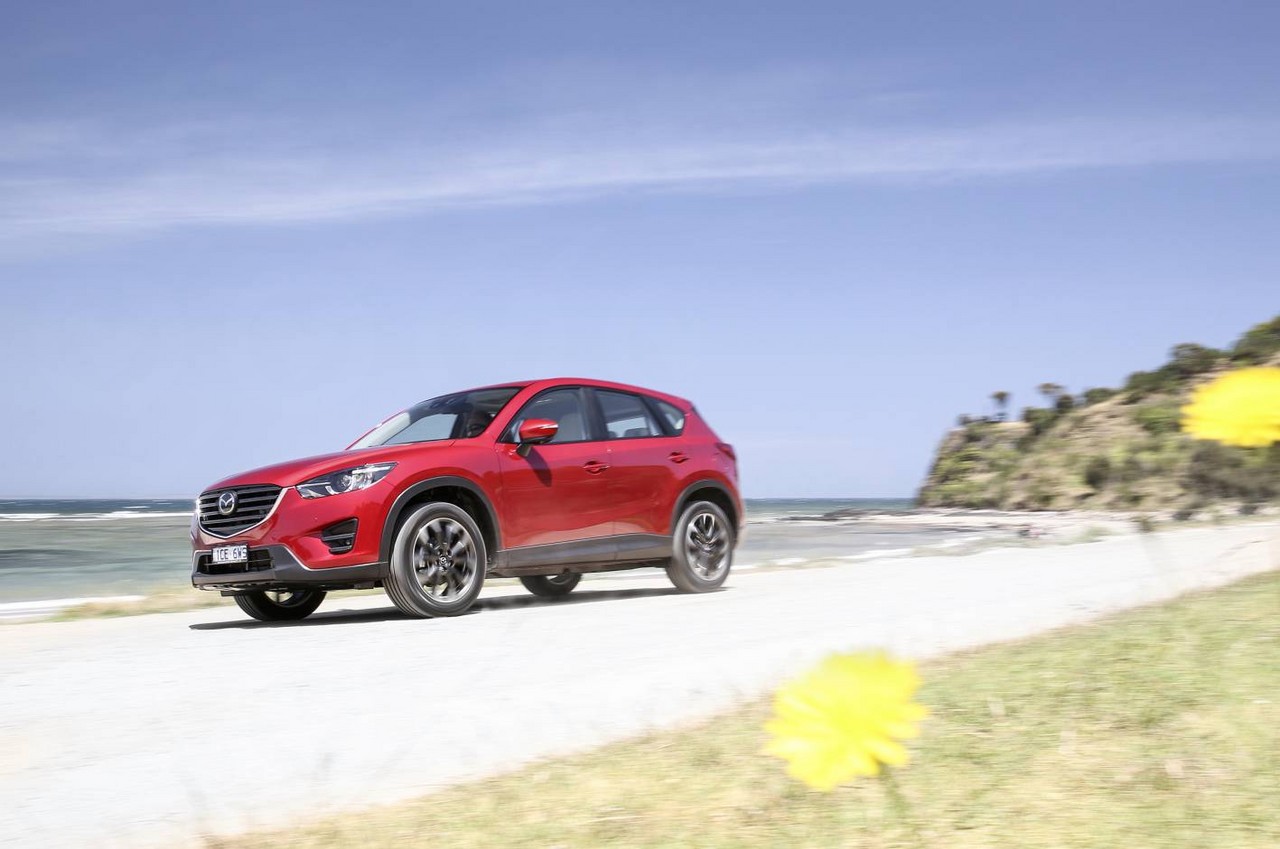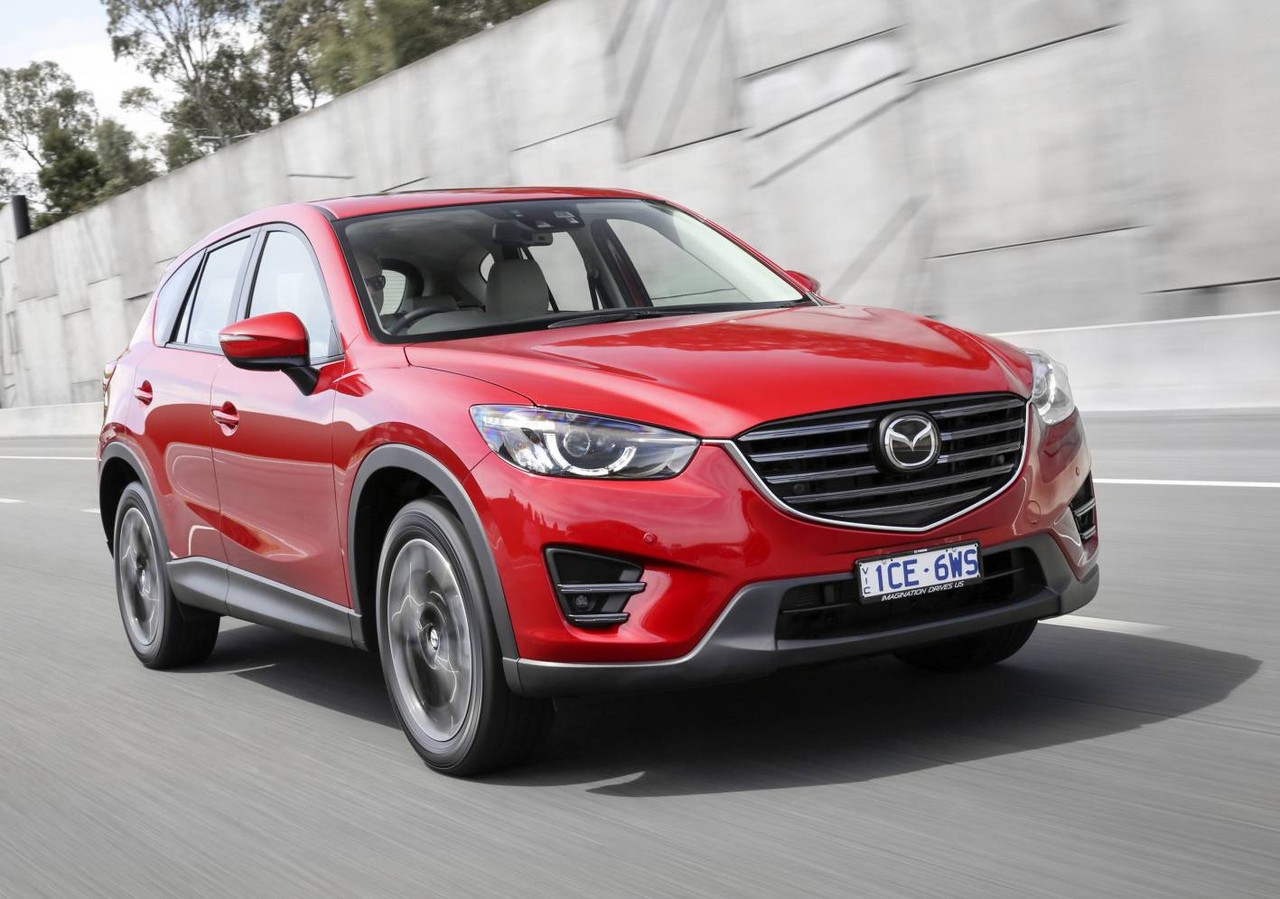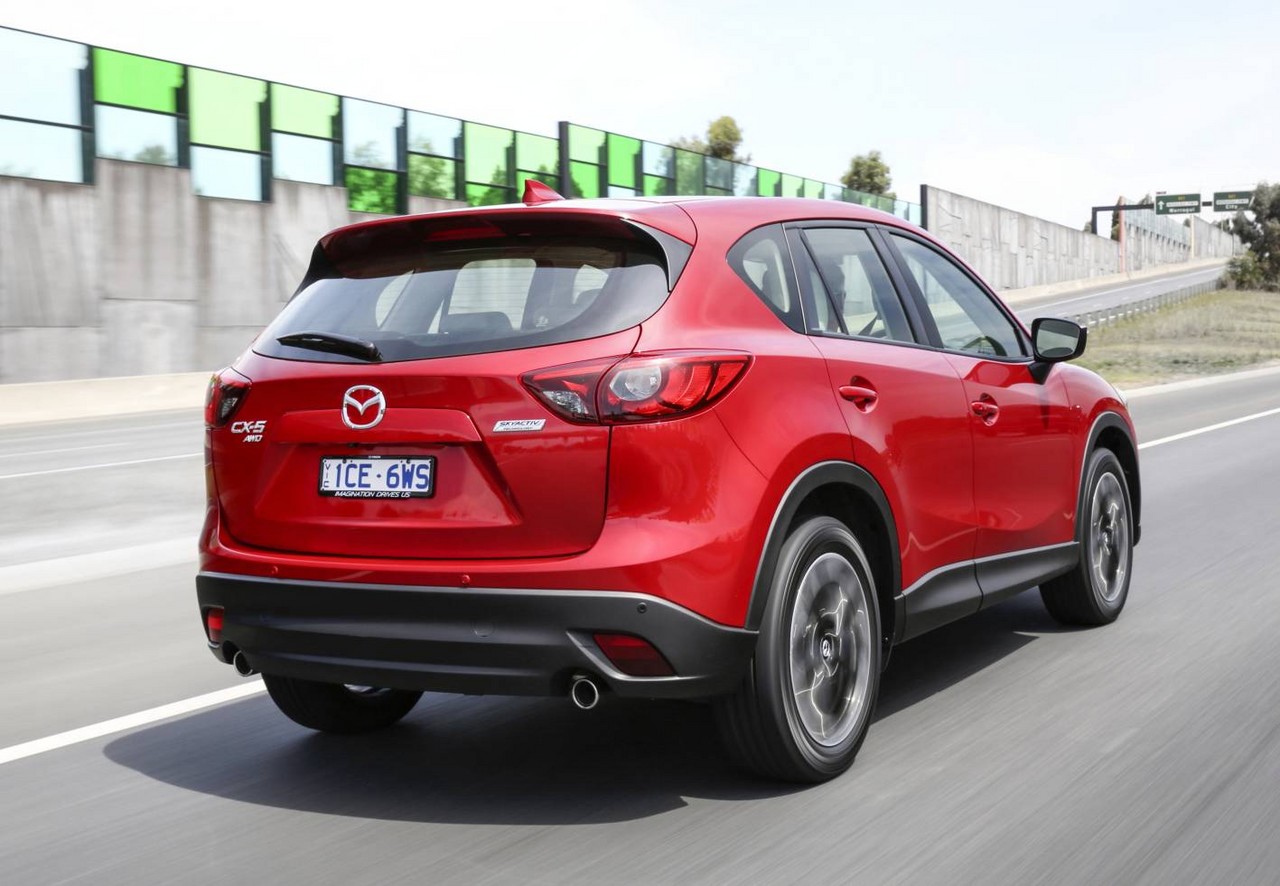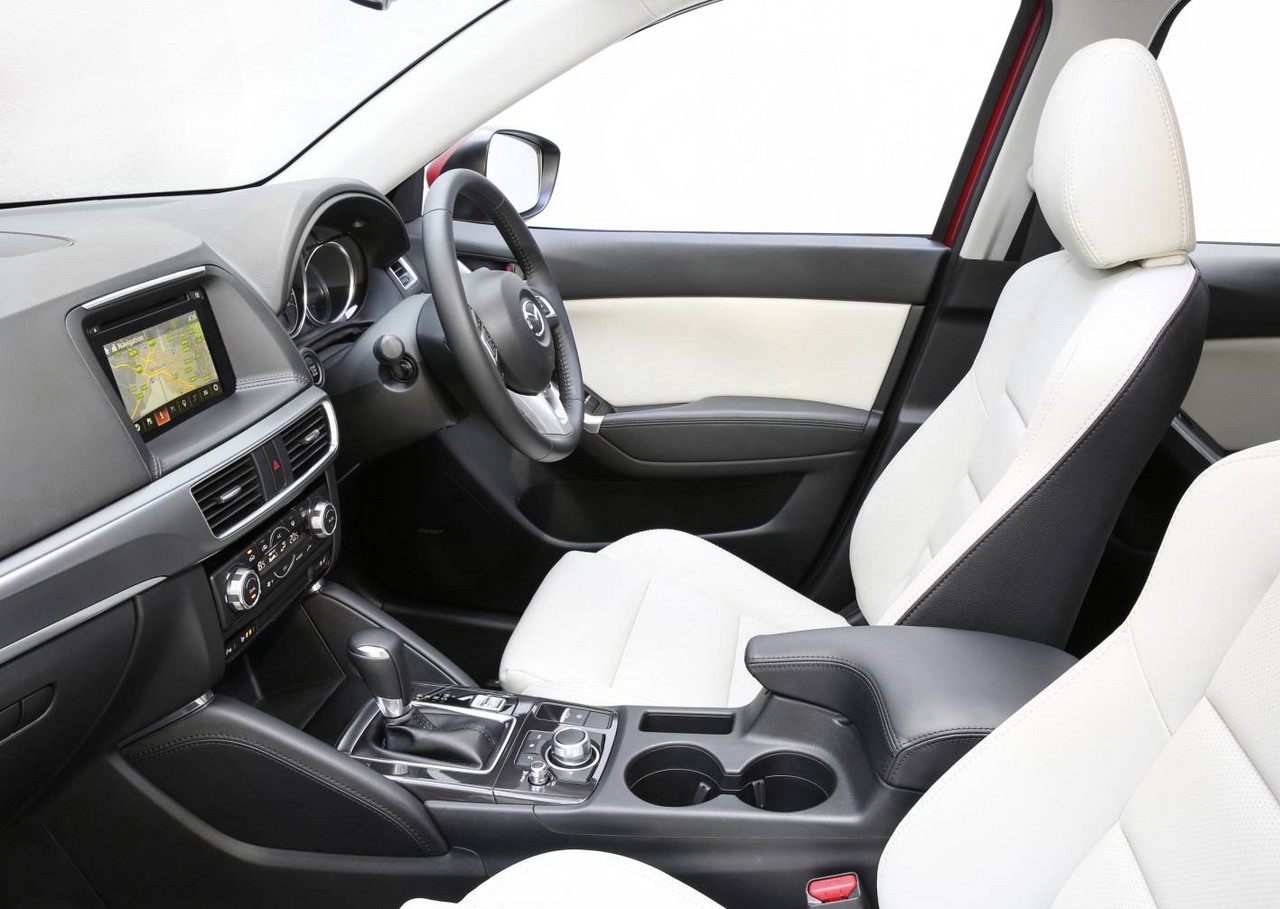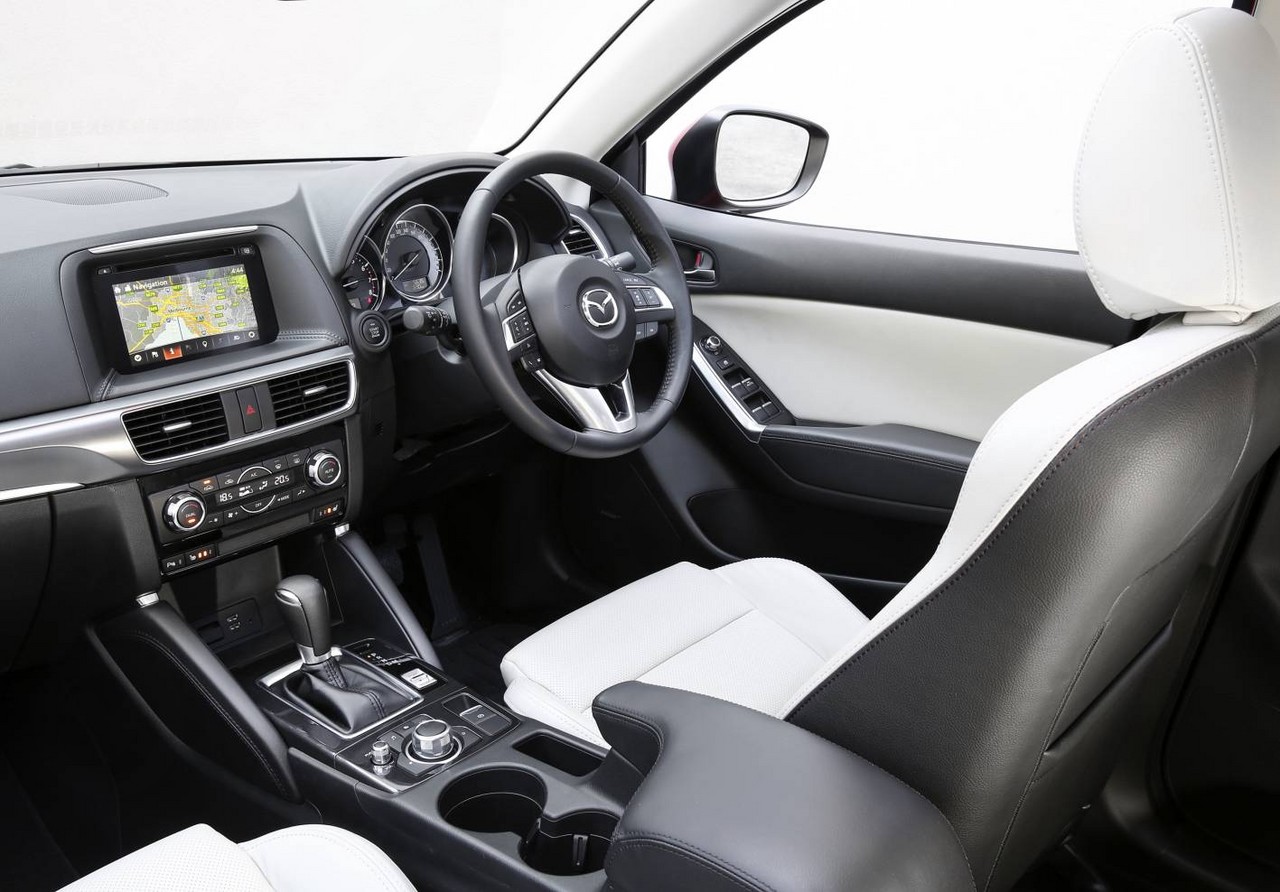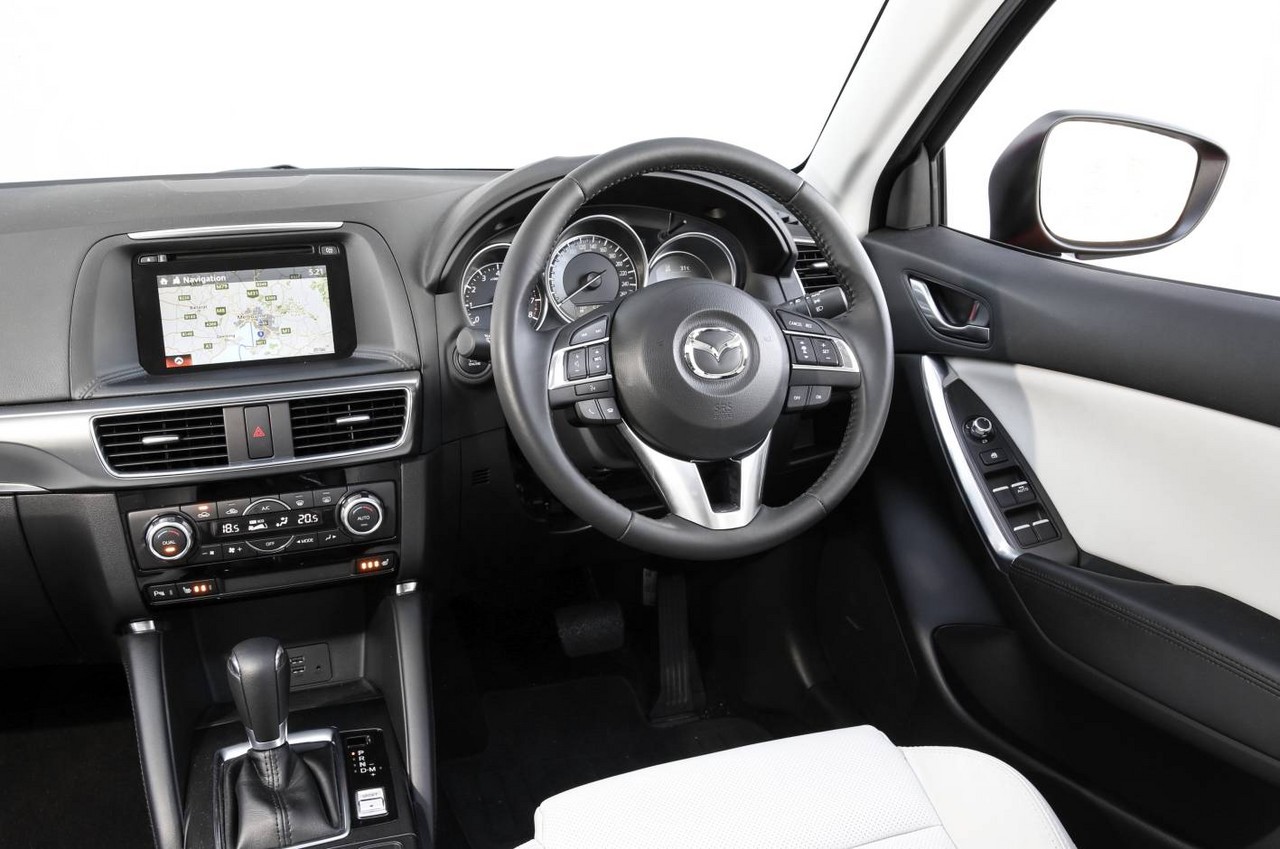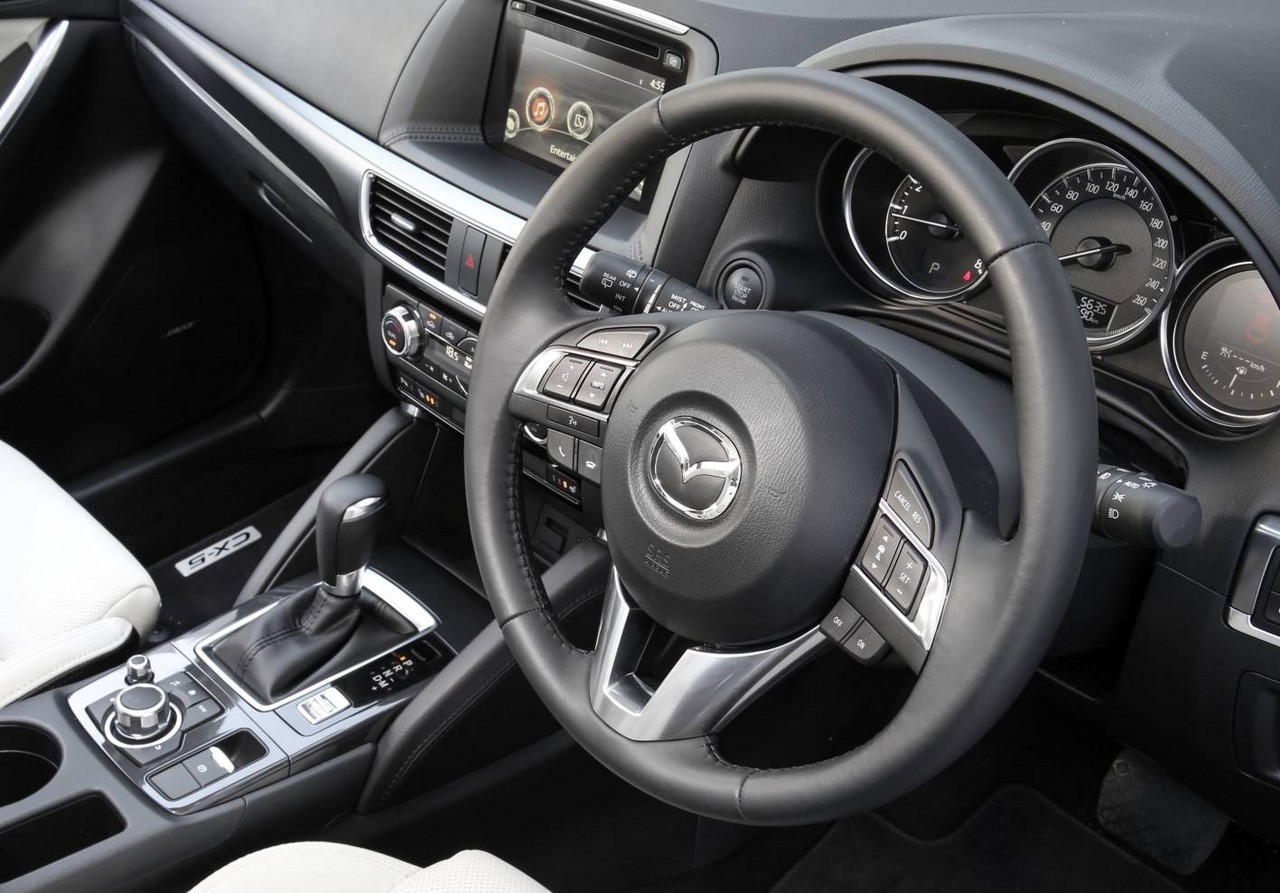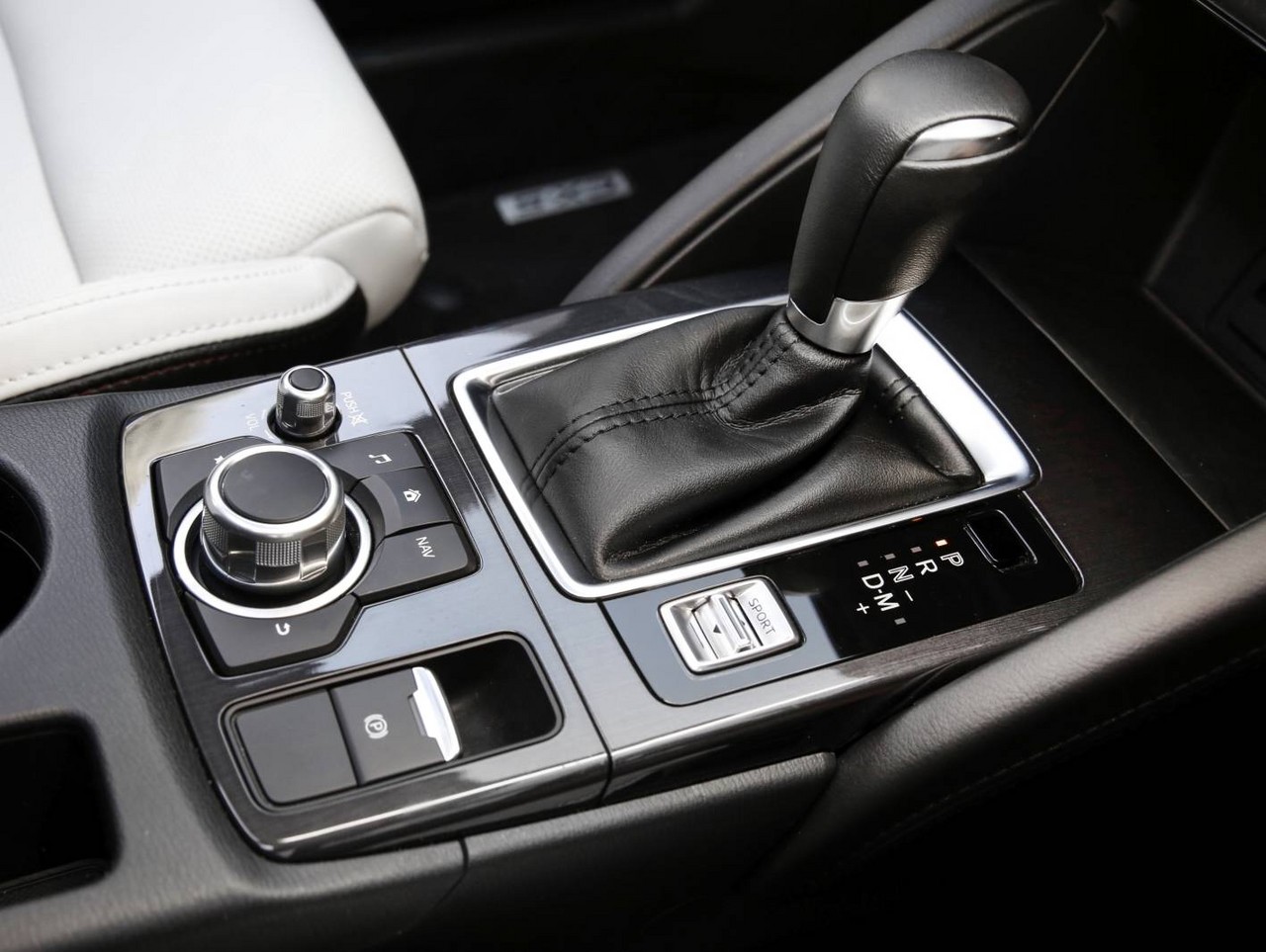
- Responsive and efficient 2.5-litre petrol and 2.2-litre diesel engines
- Excellent ride/handling balance
- Spacious interior
- Precise steering
- 2.0-litre petrol engine lacks low-rev response
- Firm ride on 19-inch wheels
- For KE.I CX-5, cabin lacks sound insulation
- ‘i-stop’ system slower to restart than rivals
Review: Mazda KE.I CX-5 (2012-14)
Overview
Released in March 2012, the Mazda KE Series I (KE.I) CX-5 was a mid-size SUV. Manufactured in Hiroshima, Japan, the CX-5 was initially available with either a 2.0-litre petrol engine or a 2.2-litre turbo-diesel engine; the former was available in front- and all-wheel drive models, though the diesel models were solely all-wheel drive.
In February 2013, however, the 2.0-litre petrol engine was replaced by a 2.5-litre unit for the all-wheel drive variants; the CX-5 range was also expanded with Akera variants.
SkyActiv-G and SkyActiv-D Engines
Of the engines,
- The 2.0-litre PE-VPS ‘SkyActiv-G’ and 2.5-litre PY-VPS ‘SkyActiv-G’ petrol engines had direct-injection, double overhead camshafts, four valves per cylinder, variable valve timing for the intake and exhaust valves (Mazda’s ‘dual S-VT’), a balance shaft, a 4-2-1 exhaust system with an extended manifold structure to reduce residual exhaust gas in the combustion chamber, a special piston cavity to reduce cooling losses and a compression ratio of 13:1. In February 2013, revised engine mapping was introduced for the 2.0-litre engines for greater acceleration; and,
- The 2.2-litre SH-VPTS ‘SkyActiv-D’ diesel engine had an aluminium block, common-rail direct-injection, a two-stage turbocharger with two turbines (a smaller turbine for low rpm and a larger turbine for more power when required) and a compression ratio of 14:1 (the world’s lowest for a diesel engine).
All engines were fitted with Mazda’s ‘i-stop’ idle-stop system which enabled the engine to shut down when the vehicle was stationary to minimise fuel consumption.
Dimensions and suspension
Compared to its CX-7 predecessor, the KE CX-5 was 153 mm shorter (at 4540 mm), 32 mm narrower (1840 mm), 65 mm taller (1710 mm) and had a 50 mm shorter wheelbase (2700 mm). Inside, cargo capacity for the CX-5 was 403 litres, increasing to 1560 litres when the rear seats were folded flat.
The CX-5 had MacPherson strut front suspension and multi-link rear suspension (both with coil springs, gas-filled dampers and anti-roll bars).
November 2013: CX-5 update
In November 2013, the CX-5 underwent a minor update which included updated damper, bush and stabiliser tuning for improved ride quality. Inside, a ‘straight shift’ automatic transmission lever was introduced.
Visually, the post-November 2013 Maxx Sport, Grand Touring and Akera variants could be identified by the new silver finish for their alloy wheels; Blue Reflex Mica and Deep Crystal Blue Mica paint finishes were also introduced.
| Engine | Drive | Years | Variants | Trans. | Peak power | Peak torque |
|---|---|---|---|---|---|---|
| 2.0-litre PE-VPS petrol I4 |
FWD | 2012-14 | Maxx | 6sp man., 6sp auto |
114 kW at 6000 rpm | 200 Nm at 4000 rpm |
| Maxx Sport | 6sp auto | |||||
| AWD | 2012-13 | Maxx, Maxx Sport, Grand Touring, Akera |
6sp auto | 113 kW at 6000 rpm | 198 Nm at 400 rpm | |
| 2.5-litre PY-VPS petrol I4 |
AWD | 2013-14 | Maxx, Maxx Sport, Grand Touring, Akera |
6sp auto | 138 kW at 5700 rpm | 250 Nm at 4000 rpm |
| 2.2-litre SH-VPTS turbo diesel I4 | AWD | 2012-14 | Maxx Sport, Grand Touring |
6sp auto | 129 kW at 4500 rpm | 420 Nm at 2000 rpm |
| 2013-14 | Akera |
AWD system
The Mazda CX-5 was available with an ‘Active Torque Split All-Wheel Drive’ system which, in normal conditions, sent all power to the front wheels for maximum fuel economy. In the event that the front wheels began to lose traction, however, two computer-controlled magnetic clutches – housed within the rear differential – would engage to direct up to 50 per cent of the engine’s torque to the rear axle (i.e. a 50:50 front:rear torque split).
Safety equipment
Standard safety equipment for the Mazda CX-5 included dual front airbags, front side airbags, full-length curtain airbags, ABS, electronic brake force distribution, brake assist, electronic stability control, traction control, active front seat head restraints and front seatbelts with pretensioners and load limiters.
The CX-5 Akera was further equipped with Blind Spot Monitoring (BSM), Lane Departure Warning (LDW) and high-beam control; these features were also available as part of an optional, extra-cost ‘Tech Pack’ for Grand Touring variants.
From November 2013, the Akera was fitted with Mazda’s ‘Smart City Brake Support’ (SCBS) as standard. Operating at speeds between 4 km/h and 30 km/h, SCBS could provide automated braking to prevent, or reduce the severity of, low-speed collisions. From November 2013, the Maxx Sport was also available with an optional Safety Pack ($1490) which included Blind Spot Monitoring and Smart City Brake Support.
Euro NCAP and ANCAP testing
In Euro NCAP testing , the CX-5 – fitted with a 2.2-litre turbo-diesel – received a five star safety rating which included a 94 per cent adult occupant protection rating and an 87 per cent child occupant protection rating. Under ANCAP’s methodology , this testing resulted in a five star adult occupant protection rating with a score of 35.1 out of 37. In the offset crash test, there was a moderate risk of serious leg injury for the driver and chest protection was rated as adequate. In the side impact and pole tests, however, maximum points were awarded.
Features: CX-5 Maxx, Maxx Sport, Grand Touring and Akera
Standard features for the Mazda CX-5 Maxx included a four speaker sound system with MP3/WMA-compatibility, auxiliary inputs (3.5mm/USB/iPod) and Bluetooth phone and audio streaming, air conditioning, cruise control, reversing camera, 60/40 split and folding rear seats, remote central locking, power windows and mirrors, a height and reach adjustable steering wheel, height adjustable driver’s seat, push-button start, tyre pressure monitoring, a trip computer and immobiliser.
The CX-5 Maxx Sport was further equipped with 17-inch alloy wheels, a six speaker sound system, a Tom-Tom satellite navigation with a 5.8-inch touch screen, dual-zone climate control air conditioning, front fog lights, automatic headlights, rain-sensing wipers, 40/20/40 split independent rear seats with a remote fold-down function and a leather-wrapped steering wheel and gear shift lever.
Beyond this, the Mazda CX-5 Grand Touring and Akera added 19-inch alloy wheels, a nine speaker Bose sound system, a power adjustable driver’s seat, leather seats, heated front seats, bi-xenon headlights with daytime running lights and washers, front and rear parking sensors, proximity key, power sunroof and electrochromatic rear view mirror.
From November 2013, both the Grand Touring and Akera variants were fitted with a six-way power adjustable front passenger seat and a driver’s seat memory function.
February 2013: Mazda CX-5 update
In February 2013, Bluetooth connectivity was upgraded an included a ‘mail function’ that enabled SMS, MMS and email to be displayed in the 5.8-inch touch screen with messaged read out by an automated voice (for compatible smartphones); the address book could also store up to 1000 contacts and calls could be made by voice command.
Paint colours
The KE.I CX-5 was available in Zeal Red Mica, Soul Red Metallic, Stormy Blue Mica, Sky Blue Mica, Meteor Grey Mica, Crystal White Pearl Mica, Jet Black Mica and Aluminium Metallic Mica paint finishes.
Brochure
Related links
- Press Kit: Mazda KE CX-5 (March 2012)
- Specifications: Mazda KE CX-5 (March 2012)
- Mazda News: Powerful new 2.5 litre engine debuts in Mazda CX-5 (February 2013)
- Mazda News: Mazda CX-5 gets pre-Christmas make-over (November 2013)
Review: Mazda KE.II CX-5 (2015-16)
Overview
Released in Australia in January 2015, the Mazda KE Series II (KE.II) CX-5 introduced cosmetic changes, additional features and greater refinement. Furthermore,
- The AWD system used low-viscosity synthetic oil for better fuel economy; and,
- For models with petrol engines and automatic transmission, a ‘Drive Selection’ function was introduced which enabled the driver to select their preferred drive mode.
Visually, the KE.II CX-5 could be identified by its bolder front grille with five grey-painted horizontal fins (previously mesh), redesigned headlights and new alloy wheel designs; the CX-5 GT and Akera variants also had LED headlights and tail-lights. The KE.II CX-5 was also available with Sonic Silver Metallic and Titanium Flash Mica paint finishes.
Inside, changes for the KE.II CX-5 included Mazda’s ‘MZD Connect’ connectivity system with seven-inch touch screen, an electric parking brake, a redesigned centre stack and floor console, better-matched ornamentation and parts, and new seat structures for greater support; the KE.II CX-5 was also available with ‘pure white’ leather upholstery. Improved sound insulation throughout the body also provided a quieter ride.
For the KE.II CX-5, the suspension was revised for greater ride comfort – changes included optimised bushing shapes for the front lower arms and a new structure for the front and rear dampers.
| Engine | Drive | Variants | Trans. | Peak power | Peak torque |
|---|---|---|---|---|---|
| 2.0-litre PE-VPS petrol I4 |
FWD | Maxx | 6sp man., 6sp auto |
114 kW at 6000 rpm | 200 Nm at 4000 rpm |
| Maxx Sport | 6sp auto | ||||
| 2.5-litre PY-VPS petrol I4 |
AWD | Maxx, Maxx Sport, GT, Akera |
6sp auto | 138 kW at 5700 rpm | 250 Nm at 4000 rpm |
| 2.2-litre SH-VPTS turbo diesel I4 | AWD | Maxx Sport, GT, Akera |
6sp auto | 129 kW at 4500 rpm | 420 Nm at 2000 rpm |
Safety equiment
Like its KE.I predecessor, standard safety equipment for the KE.II CX-5 included dual front airbags, front side airbags, full-length curtain airbags, ABS, electronic brake force distribution, brake assist, electronic stability control, traction control, active front seat head restraints and front seatbelts with pretensioners and load limiters.
The CX-5 Akera was further equipped with the following ‘i-ACTIVESENSE’ technologies:
- Mazda Radar Cruise Control (MRCC): operating at speeds between 30 km/h and 145 km/h, MRCC used a milliwave radar to judge the relative speed of and distance to the vehicle ahead. In accordance with the target speed set by the driver, MRCC would adjust the vehicle’s speed to maintain a safe distance to the vehicle ahead;
- Driver Attention Alert (DAA): operating at speeds above 65 km/h, the DAA system would initially observe driver behaviour – such as steering wheel operation, vehicle speed and lane positioning – for 20 minutes to establish a benchmark. The DAA system would then monitor driver behaviour for signs of fatigue and recommended rest breaks if detected. Alerts would also be issued if the driver had been driving continuously for more than two hours;
- Lane-keep Assist System (LAS) and Lane Departure Warning (LDW): used a forward-sensing camera to monitor lane markings on the road surface and assisted the driver to stay in their lane by providing steering torque assistance and steering wheel vibration alerts. The driver could choose from ‘Early’ or ‘Late’ settings to adjust the level of assistance and the timing of its operation. In the ‘Early’ setting, for example, the system provided continuous steering assistance to keep the vehicle in the centre of its lane;
- Blind Spot Monitoring (BSM): used radar sensors to detect vehicles approaching from behind the vehicle. If the driver activated the indicators to change lanes while a vehicle was in the driver’s blind spot, the BSM system would issue a flashing visual indicator in the respective door mirror and sound a buzzer. BSM also included Mazda’s ‘Rear Cross Traffic Alert’ which could detect approaching traffic while the vehicle was reversing;
- Smart Brake Support (SBS): operating at speeds between 15 km/h and 145 km/h, SBS used milliwave radar and a forward sensing camera to detect vehicles or obstacles on the road ahead. If a potential collision was assessed, an initial alert would sound and the brakes would be pressurised. In its secondary phase, SBS would apply the brakes lightly. If the vehicle could no longer avoid a collision, SBS would increase braking force to minimise the severity of the collision. In the event that the driver applied the brakes, braking force would be maximised;
- Smart City Brake Support (Forward/Reverse) (SCBS F/R): operating at speeds between 4 km/h and 30 km/h, SCBS Forward used a near-infrared sensor that was mounted on the windscreen for ‘precision detection’ of objects up to six metres ahead of the vehicle. For SCBS Reverse, the system operated at speeds between 2 km/h and 8 km/h and used ultrasound sensors in the rear bumper to detect obstacles up to two metres behind the vehicle. When an obstacle was detected and a high risk of collision was determined, the brakes would be applied automatically to avoid or reduce the severity of the collision; and,
- Adaptive LED Headlamps (ALH): combined ‘Glare-free High Beam’, which controlled the illumination coverage of the high beams, and ‘Wide-range Low Beam’, which expanded the area of illumination.
Safety Pack: Maxx, Maxx Sport and GT
The Mazda CX-5 Maxx and Maxx Sport could be specified with an optional, extra-cost Safety Pack which included Blind Spot Monitoring (BSM), Rear Cross Traffic Alert (RCTA), Smart City Brake Support (Forward) and an electrochromatic rear-view mirror. For the Mazda CX-5 GT, the Safety Pack added Smart City Brake Support (Forward/Reverse) (SCBS F/R), though the electrochromatic rear-view mirror was already fitted as standard.
From September 2016, however, the CX-5 Maxx, Maxx Sport and GT were fitted with the Safety Pack as standard.
Features
Standard features for the Mazda KE.II CX-5 Maxx included a four speaker sound system with a CD player, MP3-compatibility and auxiliary input (3.5 mm and USB/iPod), Mazda’s ‘MZD Connect’ system with a seven-inch colour touchscreen, internet radio integration, Bluetooth mobile phone connectivity and audio streaming, black cloth upholstery, air conditioning, cruise control, a reversing camera, 60/40 split and folding rear seats, steering wheel audio controls, remote central locking, power mirrors with folding function, power windows, a height and reach adjustable steering wheel, a height adjustable driver’s seat, an electric parking brake, tinted windows, a 12 volt power socket (cargo bay), cargo cover, vanity mirrors, push-button start, tyre pressure monitoring, a trip computer and immobiliser.
The CX-5 Maxx Sport was further equipped with a six speaker sound system, satellite navigation, dual-zone climate control air conditioning, halogen front fog lamps, automatic headlights, rain-sensing wipers, a leather-wrapped steering wheel and gearshift knob, 40/20/40 split and flat folding rear seats, and illuminated vanity mirrors.
Beyond this, the CX-5 GT and Akera added a Bose sound system with nine speakers and a 231 watt amplifier, a black leather upholstery, an eight-way power adjustable driver’s seat, a six-way power adjustable front passenger seat, heated front seats, LED headlights, LED daytime running lamps (DRLs), LED front fog lights, LED tail-lights, front and rear parking sensors, a proximity key (Mazda’s ‘advanced keyless entry’), power-operated glass sunroof, driver’s seat memory settings and an electrochromatic rear view mirror.
Paint colours
The KE.II CX-5 was available in Soul Red Metallic, Blue Reflex Mica, Jet Black Mica, Meteor Grey Mica, Crystal White Pearl Mica, Deep Crystal Blue Mica, Sonic Silver Metallic and Titanium Flash Mica paint finishes.
Related links
